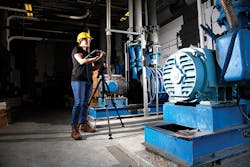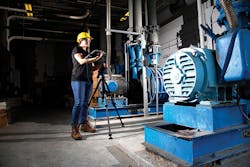High-speed imaging: Video processing method quickly identifies pump problems
Critical to the operation of each of the 500+ megawatt turbo generators at the AGL Loy Yang power station (Latrobe Valley, Victoria, Australia) are two stator coolant pumps. One of the two duty and stand-by pumps for the plant's unit 1 turbo generator has had a long history, more than 10 years, of high lateral vibration, sometimes reaching 20 mm/sec RMS.
In an attempt to remedy the problem, plant engineers and maintenance personal have at different times attempted laser alignment, base frame spot welds, adding pipe bracing, fitment of flexible bellows to the pump suction and discharge pipework, in addition to two complete pump replacements, motor replacement, and coupling replacement among others. The estimated material cost of all of these efforts according to Peter Fanning, Condition Monitoring Team Leader at AGL Loy Yang, was AU$160k, which does not take into account the estimated labor cost of more than 500 man hours and loss of power generation revenue.
After many attempts to remedy this long-standing problem, AGL Loy Yang contracted Optical Motion Technologies (OMT; Newcastle, Australia, www.opticalmotion.com.au) to apply Motion Amplification (MA) technology from RDI Technologies (Knoxville, TN, USA; www.rdi-technologies.com). The captured MA videos use a video-processing method that detects subtle motion and amplifies that motion to a level visible to the naked eye, which enabled OMT to diagnose the fault in the field within one hour from arriving at the pump location in the power station. The solution was implemented at approximately 1% of the cost of already incurred.
The process involved taking wide angle 'whole of machine' videos, analyzing them in the field and then honing in with zoomed videos on the root cause of the problem. The set up consists of a monochrome USB3 camera, vibration pads, and a professional-grade tripod, and assorted lenses. A USB3 cable connects the camera to an acquisition system that runs the imaging software.
The software and processing algorithms measure deflection, displacement, movement, and vibration not visible to the human eye, producing an easy-to-understand amplified video of motion, which enables users to assess critical operations, processes, quality, and structural components that affect plant reliability and productivity, according to Jeff Hay, CEO of RDI Technologies. The process involves the use of high definition and high dynamic range video cameras where every pixel becomes an independent point sensor creating millions of data points in an instant.
Data is collected at high frames rates (generally 120 fps or greater) to capture at speeds above the Nyquist Rate to properly sample the motions of interest. The process involves streaming video from the camera via Super Speed USB3 at data rates in the range of 350 MB/s. This allows for a high-quality data from which even the smallest of motions can be extracted.
Once the data is received by the acquisition system (a tablet PC or equivalent) the data can be processed to amplify the video. This process occurs by propriety algorithms that detect and quantify the motions after which they can be amplified in the video to be discernable by the eye. Operators can choose the level of amplification on a linear scale from 1x to 30x amplification.
It was clear from the MA videos that the problem was a soft foot condition between the pump base frame and skid base plate. In fact, there was a twisting operational deflection shape of the pump base frame. View a video of what the system produces at http://bit.ly/VSD-RDI.
During a scheduled outage, a series of fillet welds were made across the suction end the pump base frame to the skid base plate. When the pump was returned to duty service, the high lateral motion and vibration had been reduced by more than 70% and was now less than 5 mm/sec RMS. "This has proved to be a great assistance to rectifying a long-term plant issue," Fanning explains. "After only a short set up time it confirmed our vibration and phase measurement's without physically touching the plant."

